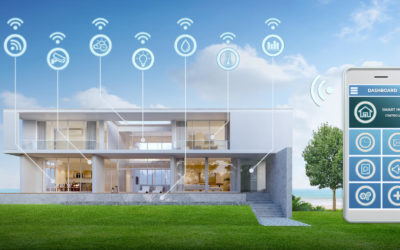With More Funds Being Invested in Improving Public Infrastructure, Embedding Connected Field Service is Strategic
29
March 2021
by David Chouraqui
As part of the global economic recovery, many nations are expected to invest trillions of dollars to improve roads, bridges, tunnels, railways, ports, public transportation hubs, and smart communities from rural towns to the largest cities and counties.
The benefits, in addition to improving the quality of life and efficiency of mission-critical systems, include the creation of jobs, the support of entrepreneurial companies, the related positive impact on the environment and the economy.
With all the funding flowing into construction on the physical side of public/private infrastructure, it is wise for developers to embed digital capabilities literally within new builds and upgrades, which will not only improve how that infrastructure is managed for decades to come but will bring jobs in the digital transformation realm.
Smart Digital Infrastructure
The road to the resiliency of future builds has many dimensions, including stability, security, agility, scalability, sustainability, and economic sense.
As the IoT continues to mature, and as connected edge systems become more powerful, with more compute at the edge, more automated control systems, and the evolving relationship between the “instrumentation” (sensors) and the cloud which can support the monitoring, management and maintenance applications in physical distributed solutions, important decisions must be made regarding who is responsible for field service, and how that field service is delivered.
It is one thing to build a new light rail system, for example, but another thing to include sensor-related technologies that “keep the trains running.” Whether positive train control (PTC) systems, people counters, security cameras, rail track vibration analyzers, or dozens of other physical/digital combinations, we must anticipate that both physical and digital aspects will fail.
Predictive and prescriptive maintenance using data analytics and AI will ensure the resiliency of modern infrastructure and has the potential to reduce operating risks and costs.
Connected Field Service platforms, like the one Cloud of Things, has had the honor to develop with our partner Prodware in Europe, and the Azure IoT and Microsoft Dynamics 365 communities, are ready for public and private service – ready to help government organizations and the construction, transportation, manufacturing, service, and security companies in the private sector to build smarter maintenance and after-sales strategies into new projects.
Big data and information technology can be used to better manage urban assets, including water supplies, energy grids, alternative energy facilities, and more. The smartest cities today use data captured by IoT devices to monitor and perform preemptive maintenance to ensure city services are always at optimal levels. As the technology matures and ecosystems like the one we are part of with our partners, sensor-driven data can be leveraged to achieve outcomes, including dramatic gains in efficiency, sustainability, mobility, economic development, health, public safety, and quality of life.
Many government agencies, working with the private sector, have already upgraded their infrastructure using sensing technologies and data analytics to better manage municipal assets. Connected sensors transmit operational data that helps cities optimize performance and maintain their physical infrastructure. Sensors send diagnostic notifications of anomalies in asset performance to field service personnel, who then diagnose and schedule preemptive maintenance.
With the right architectures and implementations, these systems can be so intuitive that field service personnel can identify which part is failing and can bring a replacement rather than diagnosing onsite and scheduling another service call. This workflow eliminates system failures and reduces costs, ensures uptime, and enhances public safety.
New builds can generate a wealth of data to improve the quality of life while spending taxpayer euros more wisely. By integrating workflow with ticketing systems, and gathering and presenting data into a single view that can be presented to a smaller but more capable control center, Connected Field Service can be delivered remotely, with intelligence built-in that can respond to anomalies (triggering a visit by a technician who can stay connected to the control center with specific data on the issue), or schedule maintenance at non-peak times, all while optimizing budgeted resources and empowering technicians.
Microsoft Dynamics 365 with Azure IoT provides a strong, agile backbone for digital operations associated with modern infrastructure projects, able to digest data generated by IoT devices, isolating issues, and triggering dispatches of trained service personnel to resolve issues before problems happen or grow. Preemptive and predictive maintenance of city assets can save taxpayer dollars significantly by committing repairs before there are costly breakdowns. Knowing the issue is and what parts are required for the fix the first time eliminates costly return visits and extends the life of these valuable assets.
For those innovative organizations wishing to pivot to Connected Field Service, Prodware’s expertise across Dynamics 365 Field Service and using our DeviceTone platform to connect, monitor, and manage the edge, which for large infrastructure projects can include diverse types of sensors and multiple streams of data being processed locally, and analyzed through edge-to-cloud applications.
Similar Blogs
The Intelligent Edge Just Got Smarter: DeviceTone’s Full Managed ULE Gateway Meets DSP Group’s ULE Module Empowering IoT Innovation
This week, Cloud of Things will be demonstrating the combination of our DeviceTone fully managed IoT cloud services gateway based on DSPG’s ULE module at the International Security Conference & Exposition, also known as ISC West, which runs from July 19-21 at the Sands Expo in Las Vegas.
DSP Group and Cloud of Things Collaborate to Introduce a Fully Managed IoT Cloud Services Gateway Based on DSP Group’s ULE Module
DSP Group, Inc. (NASDAQ: DSPG), a leading global provider of wireless and voice-processing chipset solutions for converged communications, and Cloud of Things, a developer of solutions around its DeviceToneTM technology that quickly and efficiently make products smart, announced that they will be using the upcoming ISC West trade show in Las Vegas, NV to demonstrate a fully managed Internet of Things (IoT) gateway based on ULE. An enterprise-grade device, the CoT Smart IoT Gateway securely collects sensor and equipment data from the edge of the network for localized or cloud-based analysis, relying on ULE for reliable, interference-free, full-coverage wireless communications throughout the home or office.
Data Integrity and Privacy in Smart Cities: Standardization and Collaboration is Key
According to the United Nations Population Fund, more than half of the world’s population now lives in urban areas, and it is predicted that approximately 66 percent of the world’s population will live in an urban environment by 2050.



